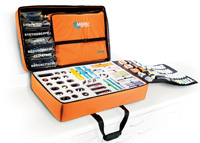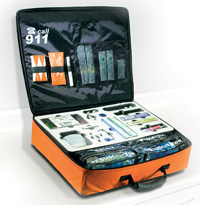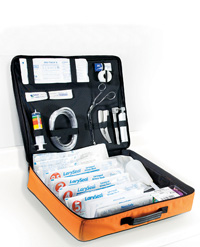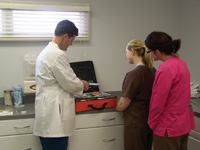We decided to write this article due to the numerous phone calls and also because of the many conversations we have been having about this subject at the conventions and professional meetings that we have been attending. We are routinely being asked questions such as “Where can I find something on an explanation of the emergency drugs?”; “Does anyone teach a course on the emergency drugs only?”; and “Is there a government course on the emergency drug kit?”
WHOA! TIME OUT!
This is something that everyone should have learned in dental school yet we are being asked constantly for a reference. You are administering local anesthetics everyday in your office, but you don’t know what each drug is being used for in your drug kit? Please note that the package insert for local anesthetics is a legal binding document and clearly states that you had better know and have emergency drugs and equipment onsite. If you do not know this now, how do you think that you would you do in a deposition in the event that you were involved in litigation due to a medical emergency?
FACTS ON THE EMERGENCY DRUG KIT
An emergency drug kit is essential in the dental setting. The American Dental Association states all dentists should have emergency drug kit and equipment along with the knowledge to properly use all items. The Council on Scientific Affairs has stated that “all dental offices” should maintain at least the basic recommended emergency equipment and drugs.1 Those drugs are albuterol, aspirin, diphenhydramine, epinephrine, glucose, nitroglycerin, and oxygen.
Emergency! What’s in the Emergency Kit?
Knowledge of the emergency drugs is a must for everyone on your dental team. Every person should be well versed in each component within the emergency drug kit. Each team member should know the action, the dose, and how to properly administer each drug in the kit. Rehearse this as a team each and every month. Never miss a month reviewing these drugs in the emergency drug kit.
The onset of a crisis is not the time to become familiar with the emergency drug kit. Sadly, so many dentists just believe that nothing will ever happen in their office. They do the first part right—that is—ordering and obtaining an emergency drug kit. Then they fail on the second part, knowing what is in the drug kit and how to use everything that it contains. Just because it is sitting on the shelf does not mean it is ready for use.
| Emergency Drug Kit Manufacturers: | ||||
|
Emergency! Where is Our Emergency Kit?
Always know the location of your emergency drug kit. This also applies to the entire dental team. What good does an emergency drug kit do if it is locked-up somewhere in the dentist’s office? The emergency drug kit needs to be visibly seen in the office and in a central location. It must be readily available for any dental team member to obtain and its location should always be known by everyone on the team, including the doctor.
Emergency! Are You Reaching for an Expired Drug?
Always use an automatic renewal update program because doctors and their team already have enough to do on a daily basis. Companies offer different types of renewal plans and you should investigate these plans fully with the company of your choice. In addition, you should know the cost of the renewal plan before you purchase a kit. Besides the renewal program, you should assign one team member in your office the duty of checking once a month for any drugs that might be expiring. This would also be a good time to rehearse the contents of the drug kit as well.
Never administer an expired drug! An expired drug is expired, period. It is good for nothing but practicing how to administer. However, you can use them for practice in mock emergency drills. If you are one of those who do not check their emergency drugs and then has a medical crisis, you are now a potential liability.
 |
 |
| Figure 1. Advanced emergency drug kit (MARK Advanced Emergency Drug Kit [Southern Anesthesia & Surgical]). | Figure 2. Classic emergency drug kit (MARK Classic Emergency Drug Kit [Southern Anesthesia & Surgical]). |
 |
| Figure 3. Airway kit (MARK Airway Kit [Southern Anesthesia & Surgical]). |
Read the Warnings on Your Local Anesthetic Inserts!
Read the package insert on the local anesthetic you are using everyday. Read the “WARNINGS” section because it contains information that you will need to know before you administer that next local anesthetic. Are you injecting local anesthetic without having emergency drugs, equipment, and knowledge of their use in your office? This is a medicolegal binding document. You need to make absolutely 100% sure that you are fully compliant.
EMERGENCY EQUIPMENT
Besides the emergency drug kit, be sure you have an automated external defibrillator (AED) as well as equipment to maintain an airway. The AED should be in every dental office. What will you do when a patient has a sudden cardiac arrest (SCA) in your office? What drug will you administer for a SCA? NONE! The only treatment for a SCA is an AED! Will EMS be at your office within 4 minutes to deliver the first shock? No! This is a piece of equipment you cannot afford to be without in your office. Do you have the proper equipment to maintain an airway? Do you have equipment to retrieve an object that might occlude an airway? Do you have equipment to maintain an airway once it is opened? Do you have equipment to deliver positive pressure? Don’t attempt the “Ziploc” approach to airway equipment. Purchase an airway kit and reduce your stress (Figure 3).
 |
| Figure 4. Take the time to perform regularly scheduled emergency procedures training with your team. |
To better assist you in understanding the drugs in the emergency drug kit, we went to Southern Anesthesia & Surgical and used their Medical Alert Rescue Kit (MARK) Series of emergency drug kits. They have developed a drug kit for every type of practitioner. We will first define the drugs contained within the MARK Classic Emergency Drug Kit. We have listed the generic name followed by trade name in ( ) and the action along with brief description of that drug: (a) indicates in kit.
MARK Classic
aAlbuterol (Proventil)—Bronchodilator: Stimulates beta-2 adrenergic receptors causing bronchodilation.
aAspirin—Antplatelet: Inhibits prostaglandin synthesis and inhibits platelet aggregation irreversibly.
aAtropine (Atropine)—Anticholinergic: Antagonizes acetylcholine at the muscarinic receptors, increasing the heart rate as well as having an antisialagogue effect.
aDiphenhydramine (Benadryl)—Antihistamine: Antagonizes histamine at the H-1 receptor, causes sedation, and has an anticholinergic effect.
aEpinephrine (Adrenaline)—Cardiac stimulant/anaphylaxis: Activates alpha- and beta-adrenergic receptors increasing heart rate, myocardial contractility, bronchial dilation, and decreases peripheral vascular resistance.
aGlucose Tabs or Insta-Glucose —Antihypoglycemic: Increases glucose level for treatment of hypoglycemia.
aNitroglycerin (Nitrostat)—Antianginal: Stimulates cGMP production which relaxes vascular smooth muscle specifically in the coronary arteries.
MARK Advanced Kit
This kit contains all drugs in the CLASSIC plus ACLS medications and reversal agents which are indicated by (b) as well as a complete Airway Kit:
bAdenosine (Adenocard)—Antiarrhythmic: Used for treatment of paroxysmal supraventricular tachycardia by slowing conduction time through the atrioventricular (AV) node as well as interrupting the re-entry pathways through the AV node.
bAmiodarone (Cordarone)—Antiarrhythmic: A Class III agent that inhibits adrenergic stimulation which prolongs the action potential, decreases AV conduction and sinus node function which is used for life-threatening recurrent ventricular fibrillation or hemodynamically-unstable ventricular tachycardia.
bDexamethasone—Anti-inflammatory: A corticosteroid secreted by the adrenal cortex which has anti-inflammatory, antiallergic, glucocorticord activity, and stimulates gluconeogenesis.
bDextrose (50% Dextrose)—Antihypoglycemic: A source of calories and fluid for patients that are not able to take oral fluids in the event of a hypoglycemic reaction.
bDiazepam (Valium)—Anticonvulsant: A benzodiazepine that acts on the inhibitory neurotransmitter gamma amino butric acid (GABA), limbic system, hypothalamus, and thalamus to produce sedation, antianxiety effect, and skeletal muscle relaxation.
bDigoxin (Lanoxin)—Antiarrhythmic: Used for the treatment of slowing the ventricular rate in atrial fibrillation, atrial flutter, and paroxysmal atrial tachycardia as well as treatment of congestive heart failure.
bFlumazenil (Romazicon)—Benzodiazepine antagonist: Reverses effect of benzodiazepines by competitively inhibiting the GABA receptors.
bFurosemide (Lasix)—Diuretic: Used for the management of congestive heart failure by inhibiting reabsorption of sodium and chloride in the ascending loop of Henle and distal renal tubule leading to an increased excretion of water, sodium, magnesium, chloride, and calcium.
Glucagon (GlucoGen)—Antihypoglycemic: Causes a rise in blood glucose levels by promoting hepatic glycogenolysis and gluconeogenesis.
Hydrocortisone (Solu-Cortef)—Anti-inflammatory: A corticosteroid secreted by the adrenal cortex which has anti-inflammatory, antiallergic, mineralocorticord activity, and stimulates gluconeogenesis.
Midazolam (Versed)—Anticonvulsant: A benzodiazepine that acts on the inhibitory neurotransmitter GABA, limbic system, hypothalamus, and thalamus to produce sedation, antianxiety effect, and skeletal muscle relaxation.
bNalbuphine (Nubain)—Narcotic: Binds to opiate receptors producing analgesia.
bNaloxone (Narcan)—Narcotic antagonist: Reverses the effect of narcotics by competitively inhibiting narcotic receptor sites.
bProcainamide (Pronestyl-SR)—Antiarrhythmic: Used for the treatment of ventricular tachycardia, premature ventricular contractions, paroxysmal atrial tachycardia, and atrial fibrillation.
bPromethazine (Phenergan)—Antiemetic/antihistamine: Used for the treatment of allergic reactions, antiemetic, and sedation.
bSodium Bicarbonate—Alkalinizing agent: Used for the management of metabolic acidosis.
bVasopressin (Pitressin)—Antidiuretic hormone: Adjunctive treatment used in pulseless ventricular tachycardia/ventricular fibrillation.
bVerapamil (Isoptin/Calan)—Antiarrhythmic: Used for the treatment of paroxysmal supraventricular tachycardia, atrial flutter, and atrial fibrillation.
CONCLUDING REMARKS
We sincerely hope that you review and update all your emergency procedures. Make sure you have a quality up-to-date emergency drug kit and appropriate emergency equipment, know where and what they are, and ensure that your entire team is trained (Figure 4) and knows how to use them—under stress in a real 911 emergency.
We also want to thank the unnamed practitioners who have had the courage to speak up and admit their deficiencies so that it may benefit others. We hope you find this a very valuable resource and share this with everyone in your office. Get prepared, and stay prepared!
Acknowledgement
We would like to thank Southern Anesthesia for allowing us to use their emergency drug kits as an example in this article. Their contact information was listed above in the list of manufacturers. Please contact Southern Anesthesia & Surgical at (800) 624-5926 or southernanesthesia.com for more information on their MARK Classic, MARK Advanced, or MARK Airway Kits.
Reference
1. ADA Council on Scientific Affairs. Office emergency kits. JADA. 2002;133:364-365.
Dr. Roberson received his DMD degree from University of Mississippi Medical Center School of Dentistry and his certification from the University of Cincinnati Medical Center Oral & Maxillofacial Surgery Residency Program. Currently, he is an oral and maxillofacial surgeon at Oral & Facial Surgery Center in Hattiesburg, Pa. Dr. Roberson is the CEO and co-founder of the Institute of Medical Emergency Preparedness. He is a member of the American Association of Oral & Maxillofacial Surgery, ADA, AGD, American Dental Society of Anesthesiology, Mississippi Dental Association, and South Mississippi Dental Society. He is also a board member of the UMC School of Dentistry Alumni Board the and the AAOMS Committee NEW OMS, and he is a past president of South Mississippi Dental Society. Dr. Roberson has lectured for more than 10 years and has published in AGD Impact, Texas Dental Journal, Journal of Oral & Maxillofacial Surgery, JADA, and Oral Surgery, Oral Medicine, Oral Pathology, Oral Radiology & Endodontics. He can be reached at (866) 729-7333, drjohnroberson@megagate.com, or visit emergencyactionguide.com.
Dr. Rothman received his DDS degree from the University of Tennessee Dental School and completed his residency at University of Cincinnati Medical Center. He is COO and co-founder of the Institute of Medical Emergency Preparedness, and is also appointed at St. Vincent’s Hospital Brookwood Medical Center in Birmingham, Alabama. He is board certified by and a Diplomate and Fellow of the American Board of Oral and Maxillofacial Surgery and the National Dental Board of Anesthesiology. He is a member of the American College of Oral & Maxillofacial Surgery, ADA, Alabama Dental Association, and the Birmingham Dental Society. He has serviced as both the vice chairman and chairman for the American Association of Oral & Maxillofacial Surgery Resident Organization. Dr. Rothman has lectured nationally, and has published in journals such as AGD Impact, Texas Dental Journal, Dental Economics, Dental Interactive, and Journal of Coordination Chemistry. He can be reached at (866) 729-7333 or drchrisrothman@yahoo.com.
Disclosure: Drs. Roberson and Rothman report no conflict of interest.






